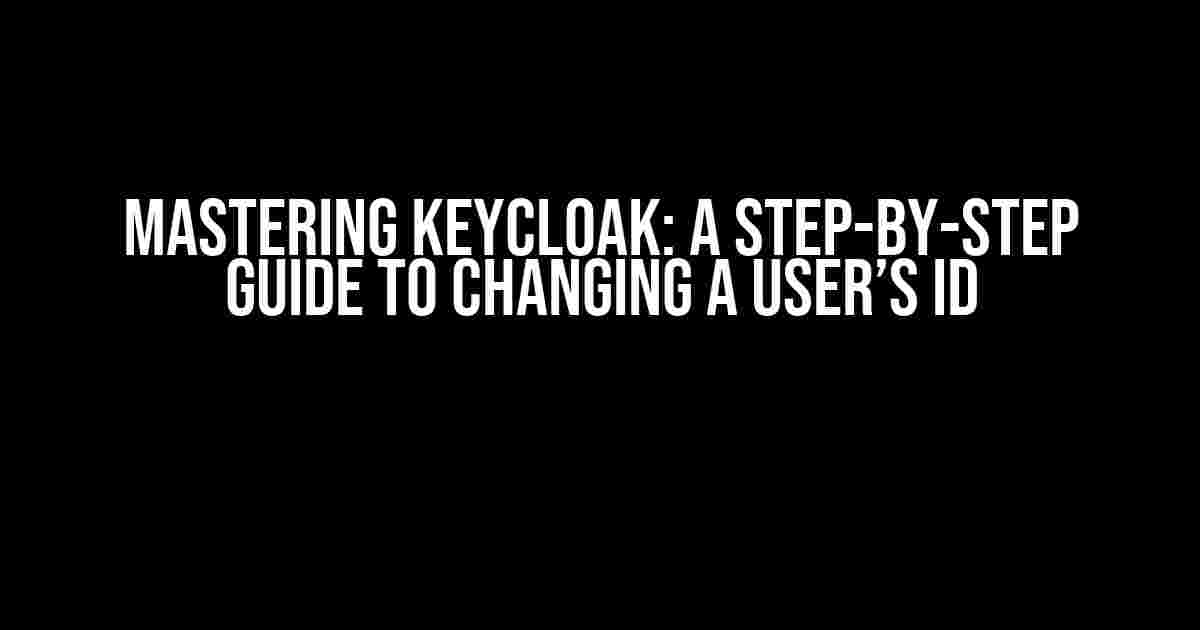Keycloak, the leading open-source identity and access management solution, provides a robust and scalable way to manage user identities. One of the most common tasks administrators face is changing a user’s ID. In this article, we’ll delve into the world of Keycloak and provide a comprehensive guide on how to change a user’s ID with ease.
Why Change a User’s ID?
There are several scenarios where changing a user’s ID becomes necessary. Perhaps the user has changed their username, or their ID has been compromised. Whatever the reason, Keycloak makes it easy to update a user’s ID while ensuring the security and integrity of your system.
Understanding Keycloak User IDs
In Keycloak, each user is assigned a unique ID, which serves as their identifier within the system. This ID is used to authenticate and authorize users, making it a crucial component of the Keycloak ecosystem.
User IDs in Keycloak are alphanumeric strings that can be up to 255 characters long. When a user is created, Keycloak generates a unique ID automatically. However, administrators can update this ID to a custom value, which is where we come in.
Prerequisites
-
A Keycloak instance set up and running
-
An administrative account with the necessary permissions to edit users
-
The user whose ID you want to change
Method 1: Changing a User’s ID through the Keycloak Console
The simplest way to change a user’s ID is through the Keycloak console. Follow these steps:
-
Log in to your Keycloak instance as an administrator
-
Click on the “Users” tab in the top navigation menu
-
Search for the user whose ID you want to change
-
Click on the user’s profile to access their details
-
Click the “Edit” button next to the “Username” field
-
Enter the new ID in the “Username” field
-
Click “Save” to update the user’s ID
Tip: Make sure to update any references to the old ID in your application or external systems to avoid authentication issues.
Method 2: Changing a User’s ID using the Keycloak REST API
For automation or programmatic changes, you can use the Keycloak REST API to update a user’s ID. Here’s an example using the `curl` command:
curl -X PATCH \
http://your-keycloak-instance.com/auth/admin/realms/your-realm/users/{user-id} \
-H 'Authorization: Bearer YOUR_ACCESS_TOKEN' \
-H 'Content-Type: application/json' \
-d '{"username": "new-id"}'
| Parameter | Description |
|---|---|
http://your-keycloak-instance.com/auth/admin/realms/your-realm/users/{user-id} |
The URL of the Keycloak REST API endpoint to update a user’s ID |
Authorization: Bearer YOUR_ACCESS_TOKEN |
The authentication token obtained from the Keycloak token endpoint |
Content-Type: application/json |
The content type of the request payload |
-d '{"username": "new-id"}' |
The request payload containing the new ID |
Tip: Make sure to replace YOUR_ACCESS_TOKEN with a valid access token and your-realm with the actual realm name.
Common Pitfalls and Troubleshooting
When changing a user’s ID, there are a few common pitfalls to watch out for:
-
Username already exists:Keycloak will prevent you from updating a user’s ID to a value that already exists in the system. Make sure to choose a unique ID. -
Invalid ID format:Keycloak has specific requirements for user IDs. Ensure the new ID meets these requirements to avoid errors. -
Authentication issues:Update any references to the old ID in your application or external systems to avoid authentication issues.
Conclusion
Changing a user’s ID in Keycloak is a straightforward process that can be accomplished through the console or using the REST API. By following the steps outlined in this article, you’ll be able to update a user’s ID with confidence. Remember to update any references to the old ID and troubleshoot common pitfalls to ensure a seamless transition.
Key Takeaways:
-
Use the Keycloak console or REST API to change a user’s ID
-
Update any references to the old ID in your application or external systems
-
Watch out for common pitfalls like username already exists and invalid ID format
With Keycloak, you have the power to manage user identities with ease. By mastering the art of changing a user’s ID, you’ll be well on your way to building a robust and scalable identity management system.
Here are 5 Frequently Asked Questions and Answers about “Keycloak Change User’s ID” in a creative tone and voice:
Frequently Asked Question
Get the inside scoop on Keycloak user ID changes!
Can I change a user’s ID in Keycloak?
Yes, you can! Keycloak allows you to update a user’s ID, but be careful – it’s a big change! You’ll need to make sure you’re updating the correct user and that you have the necessary permissions.
How do I update a user’s ID in Keycloak?
Easy peasy! You can update a user’s ID through the Keycloak admin console or using the Keycloak API. Just navigate to the user’s profile, click “Edit”, and enter the new ID. Alternatively, you can use the Keycloak API to send a PATCH request with the updated ID.
What happens to the user’s data when I change their ID?
Don’t worry, all the user’s data will still be tied to their new ID! Keycloak will automatically update the user’s data to reflect the new ID, so you don’t have to worry about losing any important information.
Can I change a user’s ID if they’re part of a group?
Yes, you can still change a user’s ID even if they’re part of a group. However, keep in mind that the user’s group membership might be affected if the group uses the user’s ID as a reference.
Are there any security considerations when changing a user’s ID?
Absolutely! When changing a user’s ID, make sure you’re following your organization’s security policies and procedures. You should also consider the potential impact on any external systems or integrations that rely on the user’s ID.

